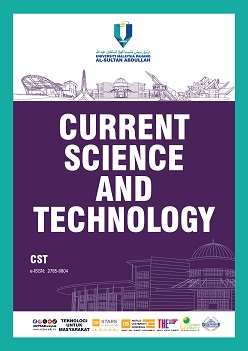Building Occupant Satisfaction Towards Indoor Environmental Quality of Library
DOI:
https://doi.org/10.15282/cst.v3i2.10282Keywords:
Occupant, Satisfaction, Indoor environment, Interior design, Indoor environmental qualityAbstract
Indoor environment is an important factor to be considered while designing a building. The quality of the indoor environment for buildings that are not in the “non -profit” category is rarely given attention. The quality of a library’s indoor environment is crucial to be highlighted as modern people are spending 90% of their time in enclosed spaces. Disruption of the indoor environment can reduce the efficiency and satisfaction of the occupants. Occupants are going to feel insecure making their job in an unhealthful environment. The purpose of this study is to assess the building occupant satisfaction in library regarding indoor environment. A total of 85 questionnaires were distributed to the users of the Kemaman District Library in Terengganu. To investigate occupants’ satisfaction, quantitative approaches were applied and evaluated by using the Statistical Package for the Social Sciences. The results of a self-assessed occupant satisfaction survey revealed that the indoor environment quality, as well as the interior design, had a positive correlation and significant effect on occupant satisfaction. Interior design accounted for 39% of occupant satisfaction since the p-value is lower than significant value (β=0.390, p-value=0.000<0.05), whereas the indoor environment quality accounted with the largest beta coefficient (β=0.497, p-value=0.000<0.05) which has explained 49.7% of the variation in occupant satisfaction. When compared to the indoor environment quality, respondents were found to be less satisfied with the interior design. This study contributes to the proposal of interior design solutions to improve and maintain occupant satisfaction in the library.
References
[1] K. Taylor, A. Post, T. B. Hoshizaki, and M. D. Gilchrist, “The effect of a novel impact management strategy on maximum principal strain for reconstructions of American football concussive events,” Proceedings of the Institution of Mechanical Engineers, Part P: Journal of Sports Engineering and Technology, vol. 233, no. 4, pp. 503–513, 2019.
[2] H. Tan, L. Qin, Z. Jiang, Y. Wu, and B. Ran, “A hybrid deep learning based traffic flow prediction method and its understanding,” Transportation Research Part C: Emerging Technologies, vol. 90, pp. 166–180, 2018.
[3] J. B. Caccese, T. A. Buckley, R. T. Tierney, K. B. Arbogast, W. C. Rose, J. J. Glutting, et al., “Head and neck size and neck strength predict linear and rotational acceleration during purposeful soccer heading,” Sports Biomechanics, vol. 17, no. 4, pp. 462–476, 2018.
[4] S. L. James, D. Abate, K. H. Abate, S. M. Abay, C. Abbafati, N. Abbasi, et al., “Global, regional, and national incidence, prevalence, and years lived with disability for 354 diseases and injuries for 195 countries and territories, 1990–2017: A systematic analysis for the Global Burden of Disease Study 2017,” Lancet, vol. 392, no. 10159, pp. 1789–1858, 2018.
[5] N. M. Jamaludin, N. Mahyuddin, and F. W. Akashah, “Assessment on indoor environmental quality (IEQ) with the application of potted plants in the classroom: Case of University Malaya,” Journal of Design and Built Environment, vol. 17, no. 2, pp. 1–15, 2017.
[6] United Nation General Assembly Economic and Social Council, Progress towards the Sustainable Development Goals Report of the Secretary-General, A/79/79-E/2024/54, https://unstats.un.org/sdgs/files/report/2024/SG-SDG-Progress-Report-2024-advanced-unedited-version.pdf, accessed 2nd January 2024.
[7] Y. Al Horr, M. Arif, A. Kaushik, A. Mazroei, and E. Elsarrag, “Occupant productivity and indoor environment quality: A case of GSAS,” International Journal of Sustainable Built Environment, vol. 6, no. 2, pp. 476–490, 2017.
[8] Z. Zhang, “The effect of library indoor environments on occupant satisfaction and performance in Chinese universities using SEMs,” Building and Environment, vol. 150, pp. 322–329, 2019.
[9] P. Šujanová, M. Rychtáriková, T. S. Mayor, and A. Hyder, “A healthy, energy-efficient and comfortable indoor environment, a review,” Energies, vol. 12, no. 8, p. 1414, 2019.
[10] Z. Kong, D. M. Utzinger, K. Freihoefer, and T. Steege, “The impact of interior design on visual discomfort reduction: A field study integrating lighting environments with POE survey,” Building and Environment, vol. 138, pp. 135–148, 2018.
[11] A. L. A. Olanrewaju and Y. S. Chong, “Post occupancy evaluation of green residential buildings, in the Greater Kuala Lumpur, Malaysia,” Journal of Housing and the Built Environment, vol.36, pp. 825–857, 2021.
[12] J. Park, V. Loftness, and A. Aziz, “Post-occupancy evaluation and IEQ measurements from 64 office buildings: Critical factors and thresholds for user satisfaction on thermal quality,” Buildings, vol. 8, no. 11, p. 156, 2018.
[13] M. Esfandiari, S. M. Zaid, and M. Azzam Ismail, “Investigating the indoor environment quality parameters and their relationship with occupants’ satisfaction in office buildings: A review,” Journal of Design and Built Environment, vol. 17, pp. 181–193, 2017.
[14] H. Xu and Y. Deng, “Dependent evidence combination based on shearman coefficient and pearson coefficient,” IEEE Access, vol. 6, pp. 11634–11640, 2017.
[15] S. Altomonte, S. Schiavon, M. G. Kent, and G. Brager, “Indoor environmental quality and occupant satisfaction in green-certified buildings,” Building Research & Information, vol. 47, no. 3, pp. 255–274, 2019.
[16] P. M. Bluyssen, M. Aries, and P. van Dommelen, “Comfort of workers in office buildings: The European HOPE project,” Building and Environment, vol. 46, no. 1, pp. 280–288, 2011.
[17] P. Pradhan, “Strengthening MaxEnt modelling through screening of redundant explanatory bioclimatic variables with variance inflation factor analysis,” Researcher, vol. 8, no. 5, pp. 29–34, 2016.
[18] Y. Geng, W. Ji, Z. Wang, B. Lin, and Y. Zhu, “A review of operating performance in green buildings: Energy use, indoor environmental quality and occupant satisfaction,” Energy and Buildings, vol. 183, pp. 500–514, 2019.
Downloads
Published
Issue
Section
License
Copyright (c) 2023 The Author(s)

This work is licensed under a Creative Commons Attribution-NonCommercial 4.0 International License.



